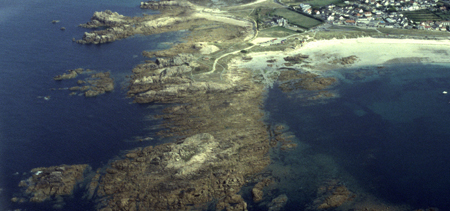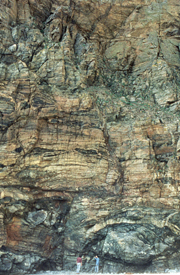Characterization of orogenic belts
Magmatic and deformational history of Neoproterozoic superterranes
To gain a fuller understanding of the magmatic evolution of orogenic belts it is necessary to determine the timing of initiation of magmatism, the duration of magmatic episodes, and whether they are discrete events (e.g., magmatic flare ups) or nearly continuous ones. Equally critical is the ability to resolve the timing of deformation events in multiply deformed orogens. A major component of that is to determine ages of variably deformed plutons intruding the superterranes that dominate the makeup of an orogen. For several years we have been studying the chemical evolution and magmatic/deformational history of several major Neoproterozoic terranes, including the Carolina terrane in the Appalachians. One approach to constrain the timing of deformation of these regions involves the determination of emplacement ages of plutons that display down-temperature deformational features. This approach avoids many of the assumptions that must be made when trying to constrain timing of peak deformation via thermochronological analysis of minerals with moderate, and chemically dependent, closure temperatures that often display evidence of partial recrystallization at the micron scale.

The ages of variably deformed plutons from Cadomian rocks in the Channel Islands is a good example of the power of this approach. Careful mapping and microstructural analysis of these intrusions identified the relative chronology of deformation, from the most deformed intrusions, technically orthogneisses (616 ± 2 Ma), to strongly deformed (613.5 ± 1 Ma) plutons, to moderately deformed (611.4 ± 1 Ma), to those displaying only magmatic fabrics (609 ± 1 Ma) (Miller et al., 1999). The order of the U-Pb dates of the intrusions agrees perfectly with the relative chronology based on the fabric analysis. This could be quantified only with high-precision, single-zircon dating as the intrusions differ in age by only a few million years and are plagued with xenocrysts. The xenocrystic complexity confounded earlier studies where multi-zircon fractions were analyzed, resulting in estimates of emplacement ages of deformed plutons that were in error by 100 Ma (Dallmeyer et al., 1991), thus producing an erroneous model of long-lived deformation of the orogen, a view which was repeatedly propagated. In reality, deformation of the region lasted only %7e 8 million years.

A similar approach was taken to constrain the timing of deformation of the Bou Azzer region of Morocco. Variably deformed gabbroic and quartz dioritic bodies had been known for a long time, and have been excellently mapped, but virtually no quantitative data were available to constrain the timing of the deformation. Using single zircon U-Pb methods we constrained the emplacement ages of the intrusions from 654 ± 1.5 Ma to 641 ± 2 Ma.

This work led to an investigation of felsic orthogneisses in the region that were considered for many decades as 2 Ga Eburnian basement gneisses. Our U-Pb work demonstrates that the gneisses actually range in age from 750–700 Ma, an interval of magmatism previously unknown in Morocco. We thus appear to have discovered a previously unknown major orogenic belt (picture, for example, discovering the Taconic or Acadian orogens), and have called into question the existence of any 2 Ga basement within these inliers (D’Lemos et al., 2006). The tectonic history of the Anti-Atlas is being completely rewritten.
Crustal growth / terrane linkage
An important aspect of orogenic belt characterization is determining the overall isotopic composition of the terranes comprising the orogen. The major reasons for doing this are twofold: (1) without a knowledge of the isotopic composition of the main components of an orogenic belt its importance in planet-wide models of continental crustal growth remain uncertain; (2) without a thorough isotopic and geochemical characterization of terranes within an orogenic belt our ability to test ideas of genetic/tectonic linkage to other geologically similar terranes, regardless of current geographical separation, are significantly hampered.

As a result, Samson and his students have put considerable effort into characterizing the Nd isotopic composition of several Neoproterozoic superterranes. In general terms one can argue that the Cadomia superterrane is largely constructed of recycled crust (D’Lemos and Brown, 1991; Samson et al., 2003), the Avalon superterrane is a mixture of new, mantle-derived crust and older, recycled crust (Samson et al., 2000), and that the Carolina superterrane (Samson et al., 1995a) and terranes within the Anti-Atlas Mountains of Morocco represent new, depleted-mantle derived continental crustal fragments (Inglis et al., 2005). But, in detailed terms, a far more interesting story emerges. Within the very evolved Cadomian superterrane there is an enigmatic crustal region that is both older than typical Cadomian crust, and, based on Nd and Hf isotopic data, is isotopically much more juvenile than average Cadomian crust (Samson et al., 2003). Based on these surprising data it appears that there is an orphan, juvenile terrane (dubbed the Port Morvan terrane) structurally caught up within the larger, crustally recycled Cadomia terrane. This is particularly intriguing as an identical result occurs in the Avalon superterrane – the Burin peninsula contains an unusually old element, identical to the age of the Cadomian orphan terrane, also of apparent depleted mantle derivation. Adding to this geological suspense tale, the newly discovered orogen in Morocco also encompasses the ages of the unique portions of Cadomia and Avalon, and shares their isotopic characteristics. From a tectonic perspective this remarkable ‘coincidence’ begs to be properly investigated.
